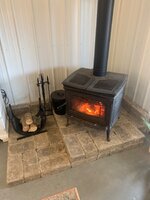I'm new to the woodstove game myself but I did go down the rabbit hole researching this past summer. The very small size of the space makes your options a bit more niche but some stuff might be relevant. Here's some factors I ran into, end of the day its a steel box that you burn things in but there are some nuances.
1: "Quality"
There seem to be about 3 general tiers of stove
Bottom: Box-store Chinese, seem to have the worst support if you have an issue.
Mid: big brand sold under multiple labels. SBI makes the same basic stove and sells it under multiple brands at various trim packages. Englander, Drolet, Osborn, etc. Easy to find parts for these and the distributers give you some better customer service than you would find at a box-store.
High: Companies making their own stoves and sell through dedicated distribution, generally with a specific selling feature. Quadrafire, Lopi, Pacific Energy, Blazeking, etc. You will get good customer service for the most part from people that know what they are talking about.
2: Burn Type:
There is a dividing line in this section based on whether the stove is EPA compliant or not. The goberment wants your stove to be efficient as possible to reduce emissions, the result is higher efficiency (more BTU's per lb of wood burned) but more finicky stoves that have some form of secondary combustion. As a result you have old school stoves like the Fischer's and niche non-listed stoves like camp stoves on one end and newer stoves designed for residential use that uses secondary air or catalytic combustion to reburn any gasses that don't get fully burned in the first pass.
2a: Non-secondary combustion stoves, just a box with a chimney hole that allows you to choke the air intake all the way down to let the fire smolder for long periods of time at low heat output. Kinda hard to mess this up but you will get a dirty chimney faster and will make a lot of smoke.
2b: Secondary air intake, basically any modern stove without a catalytic element. Just like it sounds, there is a secondary air intake path that is always active and routes through the back of the fire-box, heating the air and then providing fresh oxygen at the top of the fire box to reignite gasses. There is a balance of how hot the stove is vs much you can choke this kind of stove down before the secondary combustion fails. On the plus side, they can be cheap and make pretty flames. A burn cycle will result in a lot of heat up front and then dropping off as the wood turns to coals until you load it again.
2c: Catalytic stoves, these have a catalytic element above the firebox in the chimney vent path that you can route the smoke through once everything is hot enough and all the remaining particulates will burn up. These tend to be the most efficient and you can choke the stove way down and just combust the smolder off the main fire-box. These can also be the most finicky as they need to get up to temp before you manually re-route the exhaust through the cat. Tend to be the most expensive. Blaze King seems to do this kind of stove the best, but you wont get pretty flames as most of the time you will just be coaling the wood and combusting out of sight in the cat. A burn cycle in one of these results in a softer heat to cooling curve as you can limit the total heat output once you get up to temp and then burn at a mid level for a longer time.
So basically my takeaway from all this was that the quality of the stove is limited by budget and how much BS you are willing to put up with if something breaks in shipping or whatever, while the burn type is dictated a bit by budget but mostly by how efficient you want to be with your wood and what burn cycle style makes the most sense for your space and lifestyle.
I ended up with the biggest Drolet model and have been super happy with it. Giant firebox, relatively cheap, great ambiance from the flames, was easy to get a replacement baffle board when the original one broke in shipping.



